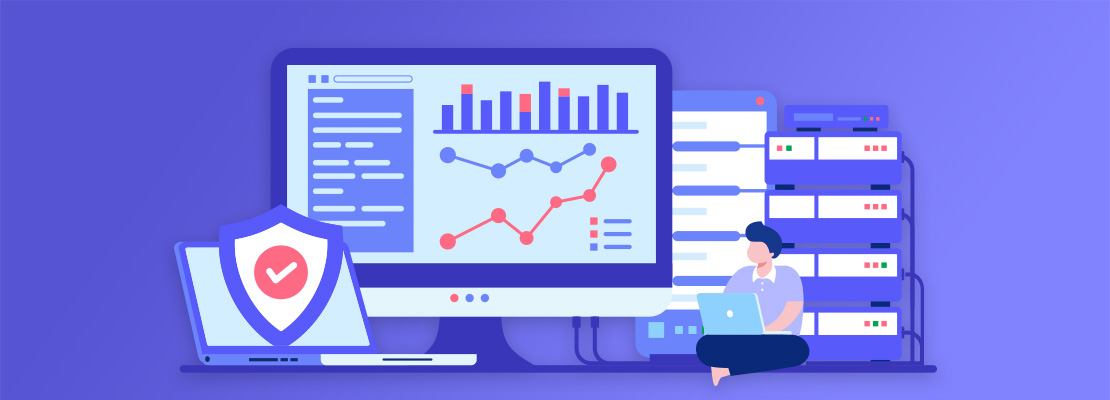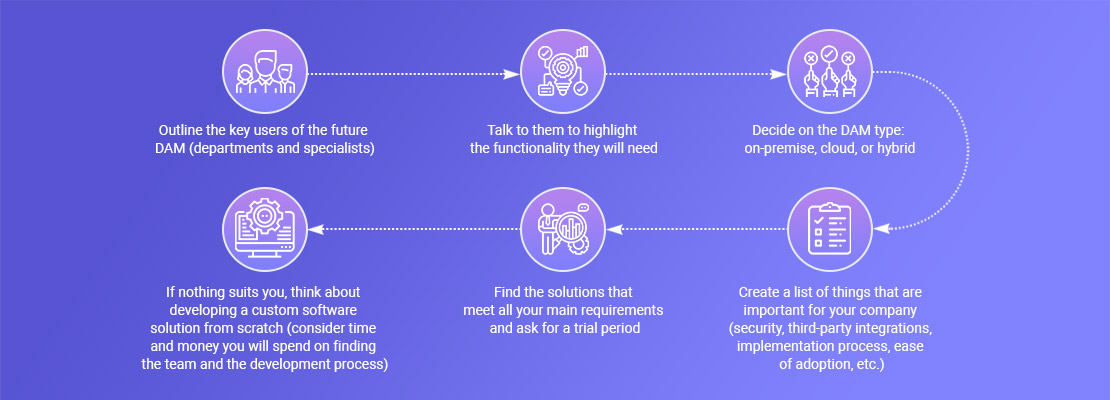Digital Asset Management: What Is It and Why Do You Need It?
Digital transformation has already changed our lives a lot and is continuing to change further, bringing new opportunities and introducing new terms like digital assets and the systems to manage them.
What is digital asset management, and why is it important? These are the notions we are going to explain in this blog post.
What Are Digital Assets?
The definition of a digital asset differs from source to source and keeps changing as more things go digital. Most often, the term refers to media content like photos, videos, and other things that represent a brand.
We would also use a digital asset to describe file-based knowledge (books, guidelines, product catalogs, training courses for new employees), software, documents, and many more things that have value for a particular company.
Summing up a range of definitions, digital assets are valuable files of different formats that state the right to use them.
Here are some examples of digital assets: photos and videos, audio files, text documents, graphics, slide decks, spreadsheets, patents, PDF files, etc. The asset can not necessarily be digital from the beginning: for example, with the help of digital publishing software, books, and newspapers are turned into digital files.
What Is Digital Asset Management?
Let us now define digital asset management. It is a combination of a software solution and an approach to a workflow that allows the organization of digital assets as well as the process of their creation, ensures effective distribution, and much more.

A good DAM (digital asset management) solution integrates with other systems used within the company in order to seamlessly fit the existing workflow.
In order to implement such a solution, it is crucial to thoughtfully plan taxonomy — the system of keywords and metadata that will be used to tag files in order to organize them effectively and find them faster and simpler.
It should be created considering the tasks of all the company’s departments and specialists that will use this DAM.
Why Is Digital Asset Management Important?
If your company has digital assets (we bet that it has), you definitely need a DAM system to improve management and reap benefits. Here are the core advantages of a digital asset management system:
Accelerated Processes
The DAM system cuts down the time employees spend searching for the required asset and eliminates the need for additional work. In case a file cannot be found, someone will have to either create a new one or upload it once more.
That will steal working time and create a duplicate file in the system. With the help of a digital asset management solution, all the assets are found quickly and easily.
Better Collaboration
DAM facilitates fast and smooth data distribution and provides tools for managing tasks (setting up deadlines and assigning them to a particular person). This helps to outline everyone’s responsibility and improve communication between teams and colleagues regardless of their location.
Faster Time-to-Market
Combining the two previous benefits, we get the acceleration of the release of new products, ad campaigns, updates, etc. This can help to leave the competitors behind as well as improve the product faster based on customers’ feedback.
Stronger Security
Security is one of the core features of a digital asset management system. Along with the mechanisms of keeping data protected, secure digital asset management software allows providing users (company employees) with different levels of access. Hence, everyone sees only the information they really need to complete tasks.
Enhanced Analytics
With the help of the DAM system, it is easier to collect, manage, and interpret data from various sources. That allows the business to empower its analytics, make predictions more accurate, and streamline decision-making.
Simplified License-Compliance
With all the assets right in front of your eyes, together with the necessary information about each of them, it is easy to track compliance with the licenses that might have changed or expired. This option eliminates the risk of missing the moment to renew the required documents.
Brand Consistency
Digital asset management systems are often used by marketing departments and companies specializing in content production.
Sharing the same materials between all the involved specialists (both in-house and contractors like agencies or freelancers) ensures maintaining brand style and consistency across all the channels the brand uses for communication.
Types of Digital Asset Management Systems
There are two main types of digital asset management solutions: on-premise and SaaS. Here are the differences:
On-premise
This type of DAM is deployed on your company’s servers, fully managed by your IT department, and relies on your network. While providing more customization opportunities and control over the data, it makes you handle such things as security, support, updates, and upgrades, as well as ensuring the required infrastructure.
SaaS
SaaS (software as a service) digital asset management systems are cloud-based and managed by the vendor. This type allows less flexibility, but it provides a number of significant benefits: global access, short deployment time, lower cost, and delegating main support and management responsibilities to your vendor.

Hybrid
There is also an option combining the advantages of both previous DAM solutions — the hybrid one. It implies having one digital asset management system that uses clouds and on-premise servers to provide easy global distribution of SaaS solutions along with the control and customization levels of hosted solutions.
Digital Asset Management Tools
Suppose your business is not large and has no specific and strict requirements; most likely, you will find an appropriate DAM system among the existing solutions. Here are some of the popular digital asset management examples:
Adobe Experience Manager Assets
A solution from Adobe focused on improving the process of content creation and distribution as well as enhancing communication between engaged departments and individuals.
Canto
A well-designed and easy-to-use tool with a user-friendly interface and an accent on visual content and productive teamwork.
Cloudinary
A digital asset management system empowered by AI that helps you with tagging. It allows for the adoption and implementation of new media requirements as fast as possible.
MediaValet
MediaValet allows uploading files up to 5TB as well as working on content in native apps like Photoshop or Sketch.
Widen
Having more than 70 years of experience in marketing, Wides provides a DAM solution that controls enterprise governance and converts files automatically.
How To Choose A Digital Asset Management System
In order to choose the most suitable variant of DAM provided in the digital asset management market, a lot should be considered. Here is a list of steps to follow:

How to Develop a Digital Asset Management System
In certain cases, organizations may find that existing Digital Asset Management (DAM) platforms do not fully meet their unique needs. In such situations, the development of a custom DAM system becomes a viable and strategic option.
Developing a DAM system requires careful planning, technical expertise, and a clear understanding of the organization’s specific requirements.
Therefore, it is necessary to entrust the project to a reliable development company that will perform the following steps to build asset management software:
Define Requirements
Before diving into development, it’s crucial to clearly define the requirements of the DAM system. This involves understanding the workflows, user roles, features, and integrations needed. Key considerations include:
- User Roles: Defining different user roles, such as administrators, contributors, and viewers, each with specific permissions and access levels.
- File Types: Identifying the types of digital assets the system will manage, whether they are images, videos, documents, or a combination of several types.
- Metadata Structure: Outlining the metadata fields necessary for quick and correct asset classification and retrieval.
- Integration Needs: Identifying any third-party systems or applications that the DAM system needs to integrate with, such as content management systems or marketing platforms.
Choose Technology Stack
Selecting the right technology stack is important for the successful development of a DAM system, as well as for scalability, security, and compatibility. Common components of a DAM technology stack include:
- Backend: Choosing a backend language or framework suitable for the organization’s needs, such as Java, .Net, Django or Laravel.
- Database: Selecting a robust database system for storing metadata and asset information, such as MySQL, PostgreSQL, or MongoDB.
- Frontend: Choosing a frontend framework for the user interface, such as React.js, Angular, or Vue.js.
- Cloud Storage: Deciding whether to use cloud storage solutions like Amazon S3, Google Cloud Storage, or Azure Blob Storage for storing digital assets.
Development
Once the requirements and technology stack are in place, it’s time to move on to the development process. Work with a skilled development team that follows an iterative development approach. Key development steps include:
- User Interface (UI) Design: Creating a convenient and compelling interface that aligns with the defined requirements.
- Backend Development: Developing the backend infrastructure to manage user authentication, file storage, metadata management, and access control.
- Integration: Implementing any necessary integrations with other systems or applications.
- Metadata Management: Developing a robust system for managing metadata, allowing for effective asset categorization and search functionalities.
Testing and Quality Assurance
Comprehensive testing is essential to confirm the DAM system functions as expected. Make sure your system passes various types of testing, including:
- Functionality Testing: Verifying that all features and functionalities work according to the specifications.
- Security Testing: Assessing the system’s security mechanisms to protect against data leak and unauthorized access.
- Performance Testing: Testing the system’s functionality under different loads to guarantee it can handle the expected user traffic.
Deployment
After successful testing, it’s vital to arrange proper digital asset management implementation. A smooth transition is usually accompanied by:
- Data Migration: If moving from an existing system, it’s crucial for data to fully migrate to the new DAM system.
- Training: Providing training sessions for users to help them get acquainted with the new system and its features.
- Monitoring: Using monitoring tools to supervise system performance and user activities post-deployment.
Maintenance and Updates
A DAM system requires ongoing maintenance to cope with any issues, implement updates, and adjust to different organizational needs. Regularly check the system, collect user feedback, and make continuous improvements based on evolving requirements.
The Bottom Line
Managing digital assets is no longer a thing you can overlook. Effectively handling digital files not only boosts productivity but also helps maintain brand consistency, promotes collaboration, and ensures overall organizational success.
Whether you choose an existing digital asset management (DAM) platform or create a customized solution, investing in a strong DAM strategy will pay off in the long term.
Having relevant expertise and experience, our software development team can help you either customize and improve the existing DAM solutions or build a new one that will perfectly meet your company’s requirements and goals. If you have any questions, feel free to contact us.












